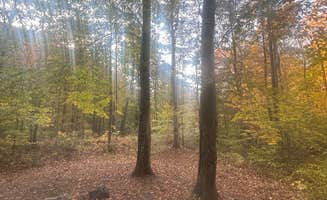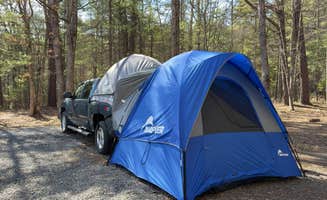George Washington National Forest offers multiple dispersed camping areas near Cedar Bluff, Virginia at elevations ranging from 1,200 to 2,500 feet. Sites along Forest Road 812 access the Appalachian Trail via rugged forest terrain characterized by oak-hickory forests and limestone outcroppings. The camping season typically runs April through October, with summer temperatures averaging 75-85°F during daytime hours.
What to do
Hiking to summits: Several dispersed sites connect to trails leading to panoramic viewpoints. At Dispersed Camping Site off FR 812, campers report "hiking trails and easy access to the stream" with a connecting path that "takes you to a gorgeous summit & links to AT." The trailhead begins approximately 50 feet from the main camping area.
Bouldering opportunities: Johns Spring Shelter provides access to climbing opportunities. According to one visitor, "there's some fairly nice bouldering to be found near the top. Some of the routes are a little under maintained and mossy, but there are some fun ones." Access requires carrying gear uphill, but rewards climbers with unique routes.
Creek exploration: Sites along Reservoir Road Dispersed Campsite offer direct access to Pedlar River. One camper notes there are "multiple spots along reservoir rd" giving options for fishing or wading. The river generally maintains moderate flow even during summer months.
What campers like
Privacy levels: Many dispersed sites offer seclusion from neighboring campers. One visitor to George Washington National Forest off 812 stated they "didn't see anyone else near this site when I stayed" and another noted "We had the absolute best time. It was so peaceful being by the creek and just relaxing."
Natural features: The combination of forest and water access rates highly among visitors. A camper at Dispersed Camping Site off FR 812 described it as "Large open space with several flat areas for tents" and called it "the furthest off the road" with "hiking trails and easy access to the stream."
Established amenities: Despite being dispersed sites, many locations have developed features. One visitor described finding "a giant fire circle in the middle and enough room to fit about 10 vehicles/groups if people don't mind being next to each other." Another camper at Sherwood Lake noted "Around a dozen sites with Rick fire rings, some are RV sized others are tent only."
What you should know
Access challenges: Roads to dispersed sites often require suitable vehicles. A camper visiting Johns Spring Shelter noted "There is not a water source too close to the shelter. The closest one is about 3 miles North." Another visitor to Reservoir Road explained it was "Very long road to get there" and "about 5 miles of dirt road."
Communication limitations: Cell service disappears quickly in the forest. One camper reported "No cell service (T-Mobile), but if I drove towards the main road, Route 501, I could get some service." Always bring physical maps and emergency supplies.
Occupancy patterns: Sites fill predictably on weekends. A visitor noted "Multiple road sites that fit my van with room to spare - 80% were full on a beautiful fall Friday evening around 6pm but still snagged one." Early arrival improves chances of securing preferred locations.
Tips for camping with families
Group-friendly spaces: Some sites accommodate multiple tents. A camper described one location as "a very nice woodsy campsite close to Natural Bridge" with room for multiple setups, while another found a site that was "a wonderful group site tucked back a couple miles from 501."
Water safety: Creeks provide natural play spaces but require supervision. Most sites along Forest Road 812 feature shallow, gentle streams as one camper described: "the sites were clean, along a gentle stream, and all had huge fire pits."
Bug preparation: Summer months bring increased insect activity. A camper visiting Reservoir Road in August reported it was "very buggy," suggesting families bring appropriate repellent and protective clothing, particularly during peak summer months.
Tips from RVers
Vehicle clearance requirements: Forest roads demand appropriate vehicles. One RVer noted "It is a very rocky path, about 50 feet long, to get into the campground, but then it is smooth and well laid out." Another mentioned needing "some clearance in some spots."
Site selection: At Sherwood Lake, "Around a dozen sites with Rick fire rings, some are RV sized others are tent only. These are located along the road to Lake Sherwood in Neola WV off Rt. 92." Smaller RVs and vans have more options than larger rigs.
Resource planning: With no hookups available at any free camping near Cedar Bluff, RVers must arrive self-contained. Bring all necessary water, as one camper noted the creek provides water only "if you have filter."





